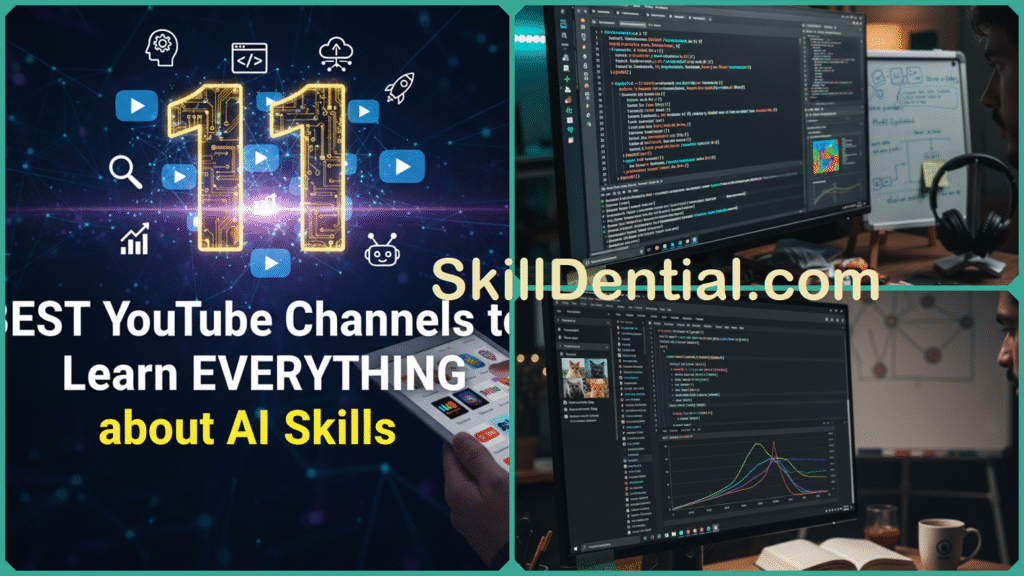Artificial Intelligence (AI) is rapidly transforming industries and reshaping careers across the globe, making skills in AI increasingly valuable and sought after in a wide variety of fields. Whether you are just starting as a beginner, a passionate tech enthusiast eager to explore new technologies, or a seasoned professional aiming to enhance your skill set and stay competitive, figuring out the best places and methods to learn AI effectively can often feel overwhelming and confusing.
Understanding where to begin and how to navigate the vast array of learning resources available is crucial for success in this exciting and fast-evolving domain. YouTube offers an accessible, diverse, and often free resource pool for mastering AI concepts, practical programming, and advanced applications.

This blog post carefully curates and highlights the 11 best YouTube channels dedicated to teaching everything you need to know about AI skills. It offers a clear and well-structured learning path that is perfectly suitable for a wide range of audiences, including absolute beginners, enthusiastic hobbyists, seasoned professionals, and those considering a career shift into the field of artificial intelligence.
These selected channels strike an excellent balance by covering foundational theories, hands-on practical projects, and the latest cutting-edge trends in Artificial Intelligence. By following these resources, learners can save significant time and effort while ensuring they receive content that is both deep in knowledge, authoritative, and highly engaging throughout their educational journey.
Key Concepts and Theories in Artificial Intelligence
To truly understand how artificial intelligence operates—and not merely what it accomplishes—you need to dive deeper into its underlying principles and mechanisms. We will thoroughly break down the essential concepts and foundational theories that constitute the bedrock of artificial intelligence, providing you with a much stronger and more comprehensive knowledge base to build upon.
Natural Language Processing (NLP) in Artificial Intelligence
Natural Language Processing, or NLP, is a vital subfield of artificial intelligence focused on enabling computers to understand, interpret, and generate human language in a meaningful way. It bridges computer science, linguistics, and machine learning to process the complexities of natural language as humans use it in speech and text.
At its core, Natural Language Processing (NLP) enables machines to not only recognize but also comprehend and effectively respond to human language through the integration of various advanced techniques and methodologies.
These combined approaches allow computers to interpret the nuances and complexities inherent in human communication, facilitating more natural and meaningful interactions between humans and machines.
- Text Preprocessing: Before analysis, raw text is prepared through tokenization (splitting text into words or phrases), removing stop words (common words like “and,” “the”), stemming or lemmatization (reducing words to their base form), and lowercasing. This standardizes data for better processing.
- Lexical and Syntactic Analysis: NLP systems analyze the structure of text by breaking it into meaningful units (words, sentences) and applying grammar rules to understand sentence construction.
- Semantic Analysis: Understanding the meaning of sentences in context, including word senses and relationships between words.
- Pragmatic Analysis: Intended meaning behind text, based on context, tone, and situational factors, which helps in grasping nuances like sarcasm or sentiment.
NLP techniques power many common technologies such as voice assistants (Amazon Alexa, Apple Siri), chatbots, language translation tools, and document summarization systems. For example, when you speak to a voice-activated assistant, NLP processes the spoken words into text, analyzes this text for commands or queries, and generates an appropriate response.
Natural Language Processing (NLP) encompasses multiple stages and components that work together to enable computers to understand, interpret, and generate human language effectively. These stages include:
- Tokenization: The process of dividing or splitting text into smaller, more manageable parts or units, often called tokens, which can be words, phrases, or symbols. This step is fundamental in natural language processing and helps in analyzing and understanding the structure and meaning of the text.
- Stop word removal: This process involves filtering out words that occur very frequently in the text but carry little meaningful information, such as common conjunctions, articles, and prepositions. These high-frequency, low-information words are removed to improve the efficiency and accuracy of text analysis.
- Stemming/Lemmatization: The process of converting words to their root forms, which involves reducing different variations of a word to a common base or root, allowing for more effective text analysis and processing.
- Part-of-Speech Tagging: This process involves identifying and assigning the correct grammatical roles or categories to individual words within a sentence, such as nouns, verbs, adjectives, adverbs, and other parts of speech. It helps in understanding the syntactic structure and meaning of the text.
- Named Entity Recognition (NER): The process of identifying and classifying proper nouns within a text, such as the names of specific people, geographical locations, or various organizations. This technique helps in extracting meaningful information by recognizing entities that are significant for understanding the content.
- Sentiment Analysis: The process of identifying and interpreting the emotional tone expressed in a piece of text, such as whether the sentiment conveyed is positive, negative, or neutral. This analysis helps in understanding the underlying feelings and attitudes communicated by the writer.
Recent advances in the field of Natural Language Processing (NLP), especially with the development of large language models (LLMs) like GPT, have dramatically enhanced the capabilities available for tasks such as text generation, question answering, and language translation.
These significant improvements have played a crucial role in driving the rapid growth and widespread adoption of generative Artificial Intelligence tools, which are now being utilized extensively across a wide range of industries and applications.
In Summary
Natural Language Processing, commonly known as NLP, empowers machines to comprehend and produce human language by thoroughly analyzing its intricate structure, underlying meaning, and contextual nuances. This advanced capability significantly enhances the way humans and computers interact, making these exchanges more natural, seamless, and intuitive.
Through NLP, machines can interpret complex linguistic patterns and respond in ways that closely mimic human communication, thereby facilitating more effective and meaningful interactions between people and technology.
The Best YouTube Channels to Learn AI Skills
Whether you are a complete beginner just starting, an experienced and seasoned developer looking to deepen your knowledge, or simply a curious enthusiast eager to explore the fascinating world of artificial intelligence, these carefully selected channels serve as the definitive and most reliable resources for mastering Artificial Intelligence.
We have thoughtfully organized and broken them down according to different learning styles and preferences to help you easily find the perfect fit and make the most of your unique educational journey in this exciting field.
For Beginners & Fundamentals
| Channle Name | Description | Target Audience | Average Video Length | Notable Features | Why It’s One of the Best |
|---|---|---|---|---|---|
| StatQuest with Josh Starmer | Breaks down complex statistics and machine learning concepts with easy-to-follow, visual explanations. | Beginners, career shifters, students | 10-30 minutes | Fun, hand-drawn visuals; “squishing” sound effects to illustrate concepts. | Fun, hand-drawn visuals; “squishing” sound effects to illustrate concepts. |
| Deeplearning.AI | The official channel of Andrew Ng’s courses, offering foundational knowledge in machine learning and AI engineering. | Beginners, professionals, students | 30-60 minutes | High-quality course lectures, interviews with AI leaders, and livestreams. | Led by one of the most respected names in Artificial Intelligence, this is a trusted and authoritative resource for a formal education. |
| Data School | Provides clear, practical tutorials on data science and machine learning using Python and scikit-learn. | Beginners, hobbyists | 5-20 minutes | Practical coding lessons, focused tutorials on specific libraries. | Kevin Markham’s tutorials are the perfect blend of theory and hands-on coding for those just getting started. |
| The Royal Institution | Explains scientific concepts, including Artificial Intelligence, with a focus on foundational understanding and high-quality production. | General audience, lifelong learners | 20-30 minutes | Well-researched talks, engaging live event recordings. | An academic-level resource that explains the “why” behind Artificial Intelligence in a compelling, digestible format. |
For Hands-On Projects & Code
| Channel Name | Description | Target Audience | Average Video Length | Notable Features | Why It’s One of the Best |
|---|---|---|---|---|---|
| Krish Naik | A go-to resource for practical, project-oriented tutorials on Artificial Intelligence, MLOps, and real-world scenario explanations. | All levels, especially those seeking a career in data science | 15-30 minutes | Real-world applications, industry insights, and coding tutorials. | Krish seamlessly blends conceptual knowledge with hands-on, end-to-end project building. |
| Sentdex | A long-running channel offering practical Python tutorials for Artificial Intelligence, machine learning, and deep learning projects. | Beginners to intermediate | 10-20 minutes | Hands-on projects, coding walkthroughs, and a focus on practical applications. | Harrison Kinsley’s no-frills, project-based approach is perfect for learning by doing. |
| Google Cloud Tech | The official channel for Google Cloud’s technical community, with a strong focus on Artificial Intelligence integration and cloud solutions. | Developers, professionals, enterprise users | 5-10 minutes | Bite-sized, practical demo videos and integration tutorials. | It’s the best place to learn how to build Artificial Intelligence into real-world applications using industry-leading cloud technology. |
| iNeuron Intelligence | Offers comprehensive, project-based tutorials on a wide range of topics from AI to full-stack development. | Intermediate to advanced learners | 1-2 hours | In-depth conceptual teaching and frequent live Q&A sessions. | Provides deep, long-form content that’s ideal for a serious, self-guided learning experience. |
For Theory, Research & News
| Channel Name | Description | Target Audience | Average Video Length | Notable Features | Why It’s One of the Best |
|---|---|---|---|---|---|
| Two Minute Papers | Summarizes the latest AI research and breakthroughs in short, engaging, and highly visual videos. | Enthusiasts, researchers, and anyone with limited time | 2-5 minutes | High-energy delivery, cutting-edge AI content from research papers. | The perfect channel for staying up-to-date with the “what’s next” in Artificial Intelligence without reading dense papers. |
| Yannic Kilcher | A deep dive into AI research papers, offering critical analysis and theory for those who want to understand the technology’s core. | Enthusiasts, researchers, academics | 20-30 minutes | Research paper reviews, detailed theory deep dives. | His in-depth analysis is a must-watch for anyone who wants to move beyond the basics and understand the science of Artificial Intelligence. |
| 3Blue1Brown | Explains the complex math behind machine learning and neural networks using stunning, intuitive animations. | Students, enthusiasts, and visual learners | 10-15 minutes | Intuitive math visuals, engaging delivery, and a focus on core concepts. | His visually beautiful explanations make the most abstract mathematical concepts crystal clear. |
Current Trends and Developments in AI Learning
Generative AI is currently at the forefront of AI education trends in 2025, with channels like iNeuron Intelligence and Google Cloud Tech dedicating extensive content to generative AI models such as ChatGPT and image generation tools. This surge reflects the technology’s transformative impact on creating personalized lessons, quizzes, and interactive learning experiences, making AI learning highly engaging and accessible.
Hands-on coding remains a crucial focus, with many popular channels emphasizing practical programming skills in Python, TensorFlow, and PyTorch. This trend aligns with the industry’s demand for actionable knowledge that learners can apply directly to projects and real-world problems, ensuring a balance between theory and practice.
Research paper decoding is gaining prominence in AI education, with creators like Yannic Kilcher leading efforts to break down complex, cutting-edge AI research papers. This approach helps enthusiasts and researchers stay abreast of the latest scientific advances and understand the theoretical underpinnings critical for innovation.
With AI’s growing integration into cloud computing, channels such as Google Cloud Tech and IBM Technology focus on deploying AI models at scale via cloud platforms. This trend reflects the industry shift towards operationalizing AI solutions in business environments, offering learners insights into AI productization and cloud Artificial Intelligence services.
Lastly, emerging content on AI ethics and societal impact is becoming more prevalent. This area educates learners about responsible AI design, governance, and the socio-legal implications of Artificial Intelligence applications, preparing professionals to deploy AI ethically and sustainably in diverse contexts.
These trends collectively highlight a dynamic, multi-dimensional approach to AI education, blending creative generative AI, technical coding skills, research literacy, cloud deployment, and ethical awareness to equip learners for the evolving Artificial Intelligence landscape.
FAQs
Can beginners learn AI effectively on YouTube?
Many channels like StatQuest with Josh Starmer, DeeplearningAI, and Data School are specifically designed to help beginners build foundational AI skills through clear, step-by-step tutorials that make complex concepts digestible. These channels gradually increase in difficulty and provide practical coding exercises to reinforce learning.
Which channel is best for practical AI projects?
For hands-on AI coding and real-world project tutorials, Krish Naik and Sentdex stand out. They offer detailed walkthroughs of AI and machine learning implementations, focusing on Python programming and popular frameworks such as TensorFlow and PyTorch, making them ideal for learners who want to apply theory to practice.
How can I stay updated with cutting-edge AI research?
Yannic Kilcher is a recommended channel for those interested in the latest AI research developments. The channel offers detailed analyses and breakdowns of recent AI papers, which help viewers remain current with trends and advancements in the field.
Are these channels free?
All the recommended YouTube channels provide extensive free content accessible to everyone. While many do offer premium paid courses for deeper learning, the free videos alone present a comprehensive resource for learning AI.
How much time should I dedicate daily to learning AI from these channels?
Consistency is key. Even dedicating about an hour each day to watching instructional videos and practicing coding can significantly improve your AI skills over time. The quality of learning and regular practice outweighs lengthy but sporadic sessions.
In Conclusion
Learning AI skills is more accessible than ever, thanks to rich resources available on YouTube. The channels listed here represent a curated blend of theory, practice, and emerging trends, suited to a broad range of learners—from absolute beginners to professionals.
For those starting, StatQuest and DeeplearningAI provide foundational knowledge, while Krish Naik and Sentdex are excellent for practical skills. Channels like Yannic Kilcher and Google Cloud Tech keep you at the frontier of AI research and application. Combining these resources will create a robust, well-rounded AI learning journey that can adapt as your skills grow.
Explore these various YouTube channels thoroughly, commit yourself to regular and consistent learning sessions, and take full advantage of their diverse teaching styles—from engaging visual storytelling to hands-on project-based tutorials—to effectively master essential AI skills and confidently future-proof your career in this rapidly evolving field.
If you are genuinely interested, subscribing to these channels and actively engaging with their community features, such as live Q&A sessions and interactive discussions, adds a valuable and dynamic dimension to your learning experience.
This active involvement not only greatly deepens your understanding of the topics at hand but also significantly broadens your opportunities for networking and connecting with like-minded individuals who share your interests and passions.
Discover more from SkillDential
Subscribe to get the latest posts sent to your email.


